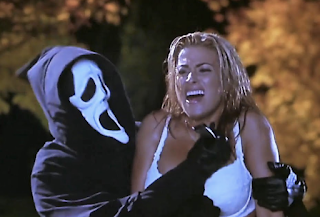There are several popular and overused tropes in the horror genre, from jump scares, to characters who aren’t believed, to swelling music in scary moments. The most popular trend is that of the final girl, scream queen and jock. In this blogpost I cover the different character archetypes in horror.
The Final Girl:
The term was invented in 1992 by author Carol J. Clover for her book Men, Women, and Chainsaws: Gender in the Modern Horror Film. She defines it as "The Final Girl is a female who is the sole survivor of the group of people being chased by a villain, and who gets a final confrontation with the villain, and who has such a "privilege" because of her implied moral superiority." She is typically a brunette, being the binary opposition of The Scream Queen. She has no interest in sex, drugs and partying. The term refers to a horror film where the last person standing is the usually virginal heroine with moral standards who outlasts her friends and kills the villain in the end.
Examples of Final Girl in Horror:
The Texas Chain Saw Massacre (1974) - Sally Hardesty
Halloween (1978) - Laurie Strode
The Cabin in the Woods (2011) - Dana Polk
The Scream Queen:
The Jock:
Conventionally, through out horror, ''The Jock'' has been presented as strong, tough and popular. At times the character of the Jock serves the purpose of comedic relief. In horror the Jock is also know as the Scream King. Similarly to the Scream Queen, his death is often a punishment for immoral behaviour.
Jocks are usually a secondary antagonist, typically embodying the common bully and meathead. You know the type; big, masculine, visually appealing, cool and athletic. Not all jocks are made up of negative traits. A good few players on this list possess some of the most endearing qualities strengthened by their dedicated athleticism.
Jocks have been a fun, quintessential trope used in a variety of horrors through the ages. Sometimes their character serve the purpose of comedic relief. While our survivor (Final Girl) rely on their brain to make it through, jocks rely on their biceps and ground tactics to take out the villains. It is, of course, a stereotype that has since been blurred by way of characterization, yet one we still see from time to time in the films we love.
Examples of Jocks in Horror:
The Cabin in The Woods (2001) – Curt Vaughan
The Killer:
The anonymous killer is usually a man wearing all black, black leather boots, holding props such as knives, hammers, chainsaws or axes etc... The killer's face won't usually be shown, making them anonymous. The use of a mask, is especially common in franchises; e.g. Ghostface in Scream (1996), Micheal Myers in Halloween (1978) and the baby mask in Happy Death Day (2017). Another element in creating a character is having a distinct weapon, such as Leatherface's chainsaw in The Texas Chainsaw Massacre (1974).Although, some slasher films do show the killer's face or reveal who the killer is at the END of the film. In some cases the killer may be female e.g. in Jennifer's body, it is also known to the audience throughout the film that Jennifer is the killer.
Slasher films often show the villains development and backstory, for example Micheal Myers' childhood bloodlust, or Friday the 13th (1980) Jason Voorhees' bullying. Another trope is a connection to the protagonist, such as Ghostface and Sidney Prescott in Scream, or Lora Lee Sherman and Jody Marken in Cherry Falls.
The use of a backstory creates further fear with the killers motives, making the killings more believable rather than a two dimensional character.











No comments:
Post a Comment